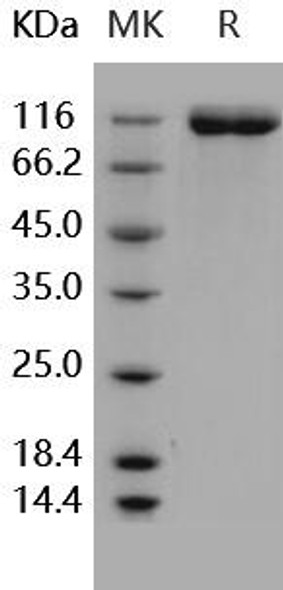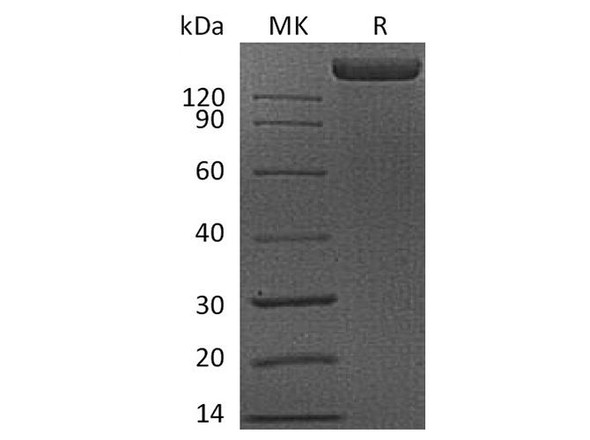Human FLT1 D7 Recombinant Protein (RPPB2530)
- SKU:
- RPPB2530
- Product Type:
- Recombinant Protein
- Species:
- Human
- Uniprot:
- P17948
- Research Area:
- Enzymes
Description
| Product Name: | Human FLT1 D7 Recombinant Protein |
| Product Code: | RPPB2530 |
| Size: | 10µg |
| Species: | Human |
| Target: | FLT1 D7 |
| Synonyms: | FLT-1, FLT1, Tyrosine-protein kinase receptor FLT, Flt-1, Tyrosine-protein kinase FRT, Fms-like tyrosine kinase 1, VEGFR-1. |
| Source: | Insect Cells |
| Physical Appearance: | Sterile Filtered White lyophilized (freeze-dried) powder. |
| Formulation: | FLT1 D1-7 was lyophilized from a concentrated (1 mg/ml) sterile solution containing PBS Buffer, pH 7.4. |
| Solubility: | It is recommended to reconstitute the lyophilized FLT1 Fc/Chimera in PBS not less than 50�g/ml, which can then be further diluted to other aqueous solutions. |
| Stability: | Lyophilized FLT-1 although stable at room temperature for 3 weeks, should be stored desiccated below -18C. Upon reconstitution FLT1 should be stored at 4C between 2-7 days and for future use below -18C. For long term storage it is recommended to add a carrier protein (0.1% HSA or BSA). Please prevent freeze-thaw cycles. |
| Purity: | Greater than 95.0% as determined by SDS-PAGE. |
| Amino Acid Sequence: | MVSYWDTGVL LCALLSCLLL TGSSSGSKLK DPELSLKGTQ HIMQAGQTLH LQCRGEAAHK WSLPEMVSKE SERLSITKSA CGRNGKQFCS TLTLNTAQAN HTGFYSCKYL AVPTSKKKET ESAIYIFISD TGRPFVEMYS EIPEIIHMTE GRELVIPCRV TSPNITVTLK KFPLDTLIPD GKRIIWDSRK GFIISNATYK EIGLLTCEAT VNGHLYKTNY LTHRQTNTII DVQISTPRPV KLLRGHTLVL NCTATTPLNT RVQMTWSYPD EKNKRASVRR RIDQSNSHAN IFYSVLTIDK MQNKDKGLYT CRVRSGPSFK SVNTSVHIYD KAFITVKHRK QQVLETVAGK RSYRLSMKVK AFPSPEVVWL KDGLPATEKS ARYLTRGYSL IIKDVTEEDA GNYTILLSIK QSNVFKNLTA TLIVNVKPQI YEKAVSSFPD PALYPLGSRQ ILTCTAYGIP QPTIKWFWHP CNHNHSEARC DFCSNNEESF ILDADSNMGN RIESITQRMA IIEGKNKMAS TLVVADSRIS GIYICIASNK VGTVGRNISF YITDVPNGFH VNLEKMPTEG EDLKLSCTVN KFLYRDVTWI LLRTVNNRTM HYSISKQKMA ITKEHSITLN LTIMNVSLQD SGTYACRARN VYTGEEILQK KEITIRDQEA PYLLRNLSDH TVAISSSTTL DCHANGVPEP QITWFKNNHK IQQEPGIILG PGSSTLFIER VTEEDEGVYH CKATNQKGSV ESSAYLTVQG TAASDKTHTC PPCPAPELLG GPSVFLFPPK PKDTLMISRT PEVTCVVVDV SHEDPEVKFN WYVDGVEVHN AKTKPREEQY NSTYRVVSVL TVLHQDWLNG KEYKCKVSNK ALPAPIEKTI S |
| Biological Activity: | The activity of FLT1/Fc was determined by its ability to inhibit the VEGF-dependent proliferation of human umbilical vein endothelial cells. The ED50 for this effect is typically 10-30 ng/ml, corresponding to a specific activity of 33,333.33-100,000 units/mg. |
Endothelial cells express three different vascular endothelial growth factor (VEGF) receptors, belonging to the family of receptor tyrosine kinases (RTKs). They are named VEGFR-1 (Flt-1), VEGFR-2 (KDR/Flk-1), and VEGFR-3 (Flt-4). Their expression is almost exclusively restricted to endothelial cells, but VEGFR-1 can also be found on monocytes. All VEGF-receptors have seven immunoglobulin-like extracellular domains, a single transmembrane region and an intracellular split tyrosine kinase domain. VEGFR-2 has a lower affinity for VEGF than the Flt-1 receptor, but a higher signalling activity. Mitogenic activity in endothelial cells is mainly mediated by VEGFR-2 leading to their proliferation. Differential splicing of the flt-1 gene leads to the formation of a secreted, soluble variant of VEGFR-1 (sVEGFR-1). No naturally occurring, secreted forms of VEGFR-2 have so far been reported. The binding of VEGF165 to VEGFR-2 is dependent on heparin.
Soluble FLT1 Human Recombinant fused with the Fc part of human IgG1 produced in baculovirus is disulfide-linked homodimeric, glycosylated, polypeptide containing 751 amino acids and having a molecular mass of 130 kDa. The soluble receptor protein contains only the first 7 extracellular domains (Met1-Thr751), which contain all the information necessary for high affinity ligand binding.The FLT1 fc/Chimera is purified by proprietary chromatographic techniques.
| UniProt Protein Function: | VEGFR1: a receptor tyrosine kinase of the VEGFR family. Receptor for VEGF, VEGFB and PGF. The VEGF-kinase ligand/receptor signaling system plays a key role in vascular development and regulation of vascular permeability. Two splice variant isoforms have been described. Isoform SFlt1 may have an inhibitory role in angiogenesis. |
| UniProt Protein Details: | Protein type:Protein kinase, TK; EC 2.7.10.1; Protein kinase, tyrosine (receptor); Kinase, protein; Membrane protein, integral; TK group; VEGFR family Chromosomal Location of Human Ortholog: 13q12 Cellular Component: extracellular space; focal adhesion; integral to plasma membrane; plasma membrane; receptor complex; endosome Molecular Function:identical protein binding; vascular endothelial growth factor receptor activity; protein binding; growth factor binding; transmembrane receptor protein tyrosine kinase activity; ATP binding Biological Process: cell migration; peptidyl-tyrosine phosphorylation; protein amino acid autophosphorylation; positive regulation of phosphoinositide 3-kinase activity; positive regulation of vascular endothelial growth factor receptor signaling pathway; positive regulation of phosphoinositide 3-kinase cascade; patterning of blood vessels; monocyte chemotaxis; positive regulation of MAP kinase activity; positive regulation of angiogenesis; positive regulation of MAPKKK cascade; positive regulation of cell proliferation; blood vessel morphogenesis; embryonic morphogenesis; sprouting angiogenesis; cell differentiation; vascular endothelial growth factor receptor signaling pathway; transmembrane receptor protein tyrosine kinase signaling pathway; positive regulation of cell migration |
| NCBI Summary: | This gene encodes a member of the vascular endothelial growth factor receptor (VEGFR) family. VEGFR family members are receptor tyrosine kinases (RTKs) which contain an extracellular ligand-binding region with seven immunoglobulin (Ig)-like domains, a transmembrane segment, and a tyrosine kinase (TK) domain within the cytoplasmic domain. This protein binds to VEGFR-A, VEGFR-B and placental growth factor and plays an important role in angiogenesis and vasculogenesis. Expression of this receptor is found in vascular endothelial cells, placental trophoblast cells and peripheral blood monocytes. Multiple transcript variants encoding different isoforms have been found for this gene. Isoforms include a full-length transmembrane receptor isoform and shortened, soluble isoforms. The soluble isoforms are associated with the onset of pre-eclampsia.[provided by RefSeq, May 2009] |
| UniProt Code: | P17948 |
| NCBI GenInfo Identifier: | 143811474 |
| NCBI Gene ID: | 2321 |
| NCBI Accession: | P17948.2 |
| UniProt Secondary Accession: | P17948,O60722, A3E342, A3E344, A8KA71, B0LPF1, B2BF46 B2BF47, B2BF48, B3FR89, B5A923, F5H5L6, |
| UniProt Related Accession: | P17948 |
| Molecular Weight: | 41,175 Da |
| NCBI Full Name: | Vascular endothelial growth factor receptor 1 |
| NCBI Synonym Full Names: | fms-related tyrosine kinase 1 |
| NCBI Official Symbol: | FLT1�� |
| NCBI Official Synonym Symbols: | FLT; FLT-1; VEGFR1; VEGFR-1�� |
| NCBI Protein Information: | vascular endothelial growth factor receptor 1; fms-like tyrosine kinase 1; tyrosine-protein kinase FRT; tyrosine-protein kinase receptor FLT; vascular permeability factor receptor; fms-related tyrosine kinase 1 (vascular endothelial growth factor/vascular permeability factor receptor) |
| UniProt Protein Name: | Vascular endothelial growth factor receptor 1 |
| UniProt Synonym Protein Names: | Fms-like tyrosine kinase 1; FLT-1; Tyrosine-protein kinase FRT; Tyrosine-protein kinase receptor FLT; FLT; Vascular permeability factor receptor |
| Protein Family: | Vascular endothelial growth factor receptor |
| UniProt Gene Name: | FLT1�� |
| UniProt Entry Name: | VGFR1_HUMAN |










